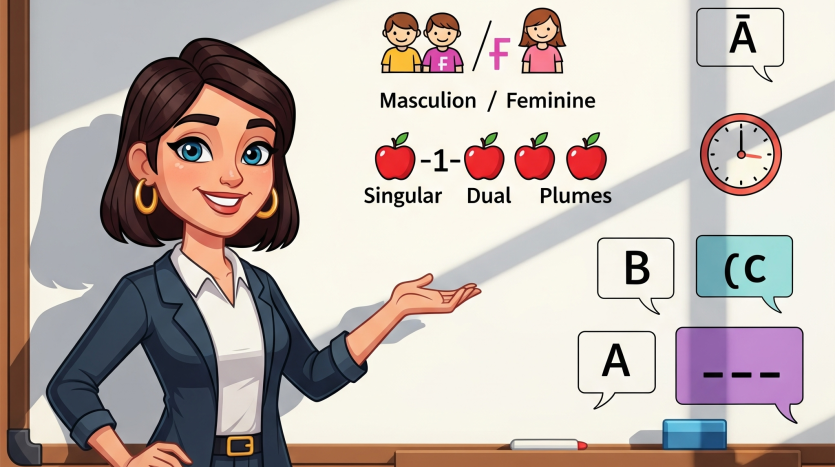Simplifying Arabic Grammar: Your Comprehensive and Easy Guide for Beginners
Have you started your journey learning Arabic and find its grammar seems like a maze? Don’t worry, you’re not alone! Arabic grammar, despite its richness and precision, can be simplified and made understandable even for beginners. This comprehensive guide will take you step-by-step, presenting the most important rules in an easy and accessible way, helping you build a solid foundation for your linguistic journey.
Chapter One: The First Basics (Sentence and Word)
Concept of the Sentence in Arabic:
- Nominal Sentence (starts with a noun): Simple examples (The house is big – البيت كبير, The student is diligent – الطالب مجتهد).
- Verbal Sentence (starts with a verb): Simple examples (The boy went – ذهب الولد, The student wrote – كتب الطالب).
Parts of a Word (Noun, Verb, Particle):
Simple explanation for each part with examples.
- Noun (الاسم): Denotes a person, animal, plant, inanimate object, or quality (Muhammad, cat, tree, pen, beautiful).
- Verb (الفعل): Denotes an action linked to a time (past, present, imperative): كتب (wrote), يكتب (writes), اكتب (write – imperative).
- Particle (الحرف): A word that has no meaning except when combined with others (في (in), على (on), من (from), إلى (to)).
Chapter Two: Masculine and Feminine (Gender)
Importance of Masculine and Feminine:
In nouns, verbs, and adjectives.
Feminine Markers:
- Ta’ Marbuta (ة): (مدرسة – school, شجرة – tree).
- Alif Maqsura (ى): (ذكرى – memory, سلوى – solace).
- Alif Mamdooda (اء): (صحراء – desert, خضراء – green).
- Feminine Nouns without Visible Markers (Sama’i Feminine): شمس (sun), أرض (earth), عين (eye).
Chapter Three: Singular, Dual, and Plural (Number)
- Singular (المفرد): Denotes one (طالب – male student, طالبة – female student).
- Dual (المثنى): Denotes two:
- Adding “ان” or “ين” (طالبان/طالبين – two male students, طالبتان/طالبتين – two female students).
- Plural (الجمع): Denotes more than two:
- Sound Masculine Plural (جمع المذكر السالم): Adding “ون” or “ين” (معلمون/معلمين – male teachers).
- Sound Feminine Plural (جمع المؤنث السالم): Adding “ات” (معلمات – female teachers, طالبات – female students).
- Broken Plural (جمع التكسير): Does not follow a specific rule and the singular form changes (كتاب – book -> كتب – books, قلم – pen -> أقلام – pens).
Chapter Four: Pronouns (أنا, أنت, هو, هي, etc.)
- Detached Subject Pronouns (ضمائر الرفع المنفصلة):
- For the speaker (أنا – I, نحن – we).
- For the addressed (أنتَ – you (m), أنتِ – you (f), أنتما – you (dual), أنتم – you (m. pl), أنتن – you (f. pl)).
- For the absent (هو – he, هي – she, هما – they (dual), هم – they (m. pl), هن – they (f. pl)).
- How to use them with verbs and nouns: Simple examples.
Chapter Five: Verbs and Their Tenses (Past, Present, Imperative)
- Past Verb (الفعل الماضي): Action completed (كتب – wrote, ذهبت – went (f)).
- Present Verb (الفعل المضارع): Action happening now or will happen (يكتب – writes, تذهب – goes (f)).
- Imperative Verb (فعل الأمر): Command to perform an action (اكتب – write, اذهب – go).
- Conjugation of Basic Verbs with Pronouns: Very simple examples.
Chapter Six: Prepositions (في, على, من, إلى, etc.)
- Importance: Connecting words and sentences.
- Most common prepositions and their basic meanings:
- في (in/inside): في البيت (in the house).
- على (on/upon): على الطاولة (on the table).
- من (from – starting point): من المدرسة (from the school).
- إلى (to – ending point): إلى السوق (to the market).
- بـ (with/by means of): كتب بالقلم (wrote with the pen).
- لـ (for/possession): الكتاب للطالب (The book is for the student).
- Majrur Noun (الاسم المجرور): The noun that comes after a preposition.
Additional Tips for Learning Grammar:
- Practical Application: Don’t just memorize; try to use rules in sentences.
- Reading and Listening: Observe how native speakers use grammar.
- Patience and Continuous Review.
- Use User-Friendly Resources: Like this article and educational apps.
Conclusion:
Understanding grammar rules is the key to unlocking the Arabic language with fluency and confidence. Don’t let its apparent complexity discourage you. Start with these basics, practice regularly, and you’ll find yourself steadily progressing towards mastering this beautiful language.

